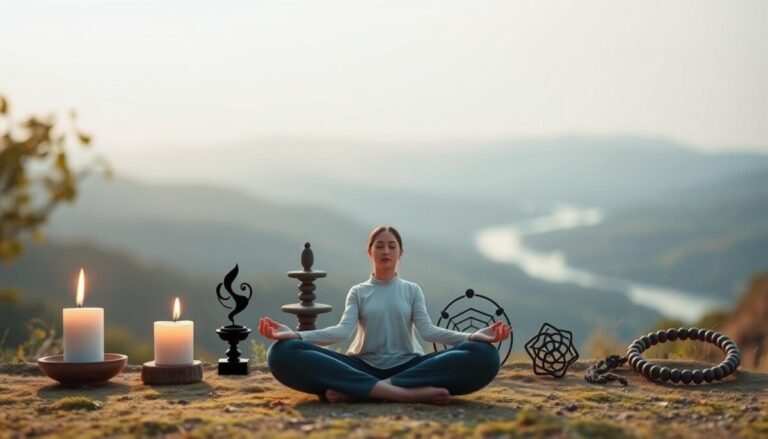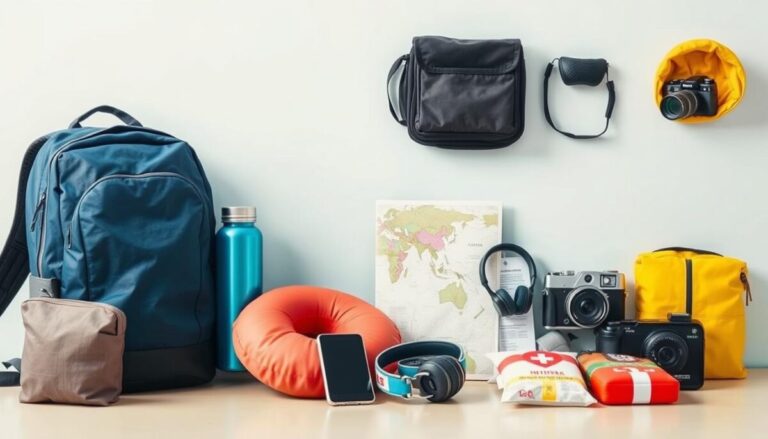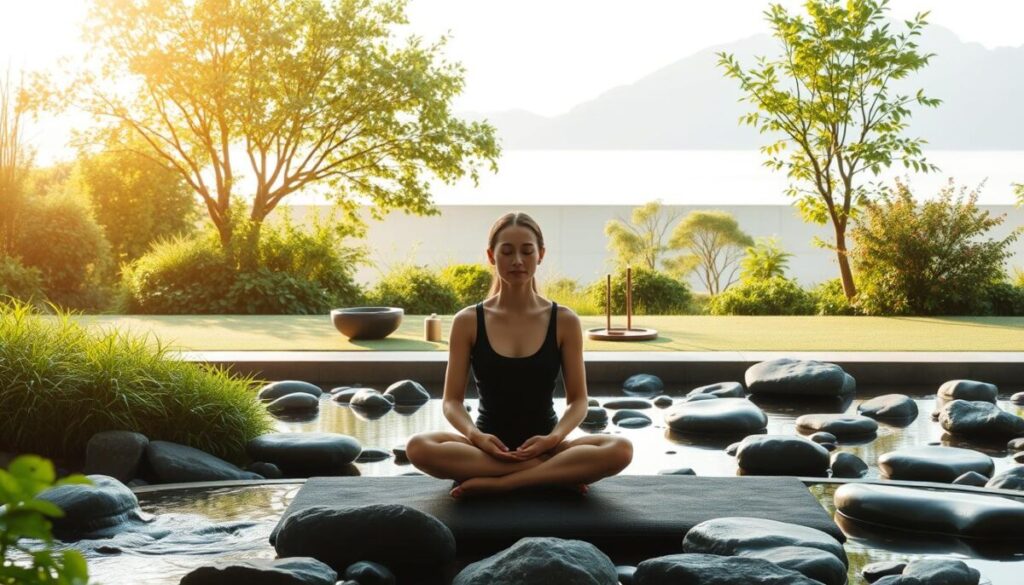
Learn to bring calm and clarity into your day in just a few minutes. Practicing mindfulness is simple and easy. It fits right into your daily routine.
By adding simple practices to your daily life, you can reduce stress and improve focus. Learning how to practice mindfulness brings instant peace of mind. It also boosts your overall well-being.
What is mindfulness, and how can it benefit my daily life?
Mindfulness is about being fully present in the moment. It means noticing your thoughts, feelings, and body without judgment. It can make you less stressed, better at handling emotions, and happier overall.
Key Takeaways
- Reduce stress with simple mindfulness exercises
- Improve focus and concentration
- Enhance overall well-being
- Practice mindfulness in just a few minutes a day
- Achieve instant peace of mind
What Is Mindfulness and Why It Matters
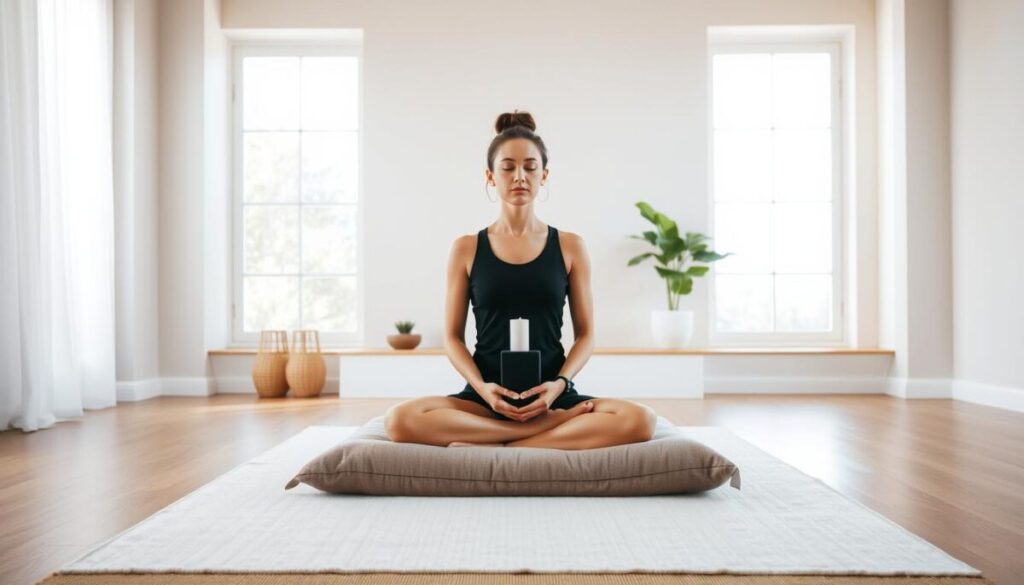
Mindfulness is about being fully present in the moment. It means noticing your thoughts, feelings, and body sensations without judgment. By doing this, you can understand yourself better and handle life’s challenges more effectively.
The Science Behind Mindfulness
Research shows that mindfulness meditation techniques are good for your health. They can lower stress, improve mood, and boost brain function. Mindfulness changes how our brains work, making them more flexible.
Common Misconceptions About Mindfulness Practice
Many think mindfulness is a religious practice. But it’s not. It has Buddhist roots, but it’s not religious. Another myth is that you need a lot of time or special training to practice mindfulness. But you can start with simple exercises anytime, anywhere.
The Benefits of Regular Mindfulness Practice

Regular mindfulness practice can change your life for the better. It improves many areas of your life. By doing mindfulness exercises, you can see real changes.
Physical Health Benefits
Mindfulness for beginners starts with simple steps that help a lot. It can lower chronic pain, blood pressure, and boost your immune system. Research shows meditation helps with high blood pressure and insomnia.
Mental and Emotional Advantages
Mindfulness also boosts your mental and emotional health. It reduces stress, anxiety, and depression. It teaches you to stay present and focused. This helps you handle tough situations better.
“Mindfulness is the practice of paying attention in a particular way, on purpose, in the present moment, non-judgmentally.”
Improved Relationships and Social Connections
Mindfulness also makes your relationships better. Being present and attentive in talks helps you communicate better. This builds stronger, more meaningful connections. It also increases your sense of community and support.
| Benefits | Description |
|---|---|
| Physical Health | Reduces chronic pain, lowers blood pressure, boosts immune system |
| Mental & Emotional | Reduces stress, anxiety, depression, promotes emotional regulation |
| Social Connections | Improves communication, builds stronger relationships |
Essential Mindfulness Tips You Can Practice Anywhere
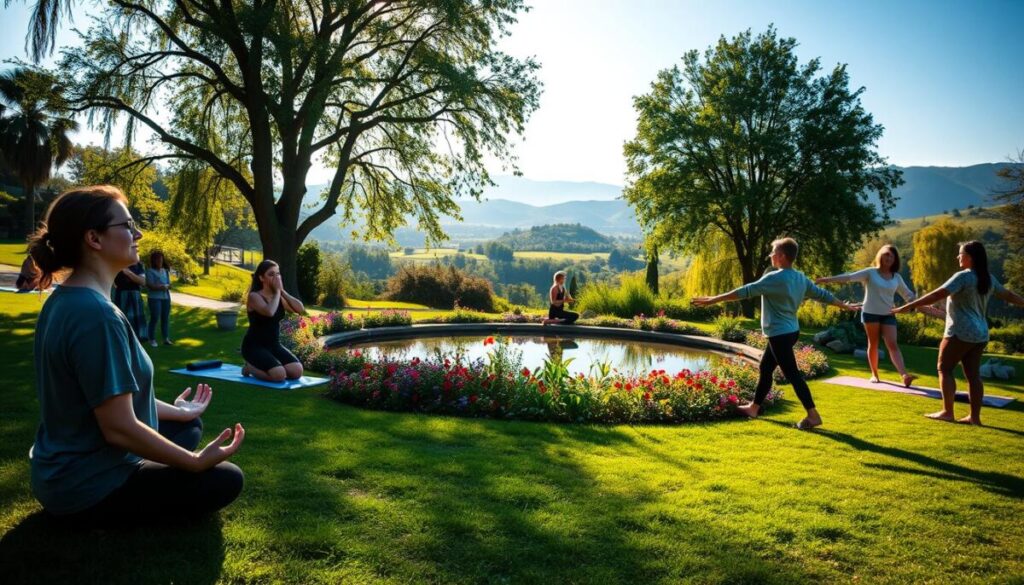
Mindfulness isn’t just for meditation. You can use it in your daily life. Simple exercises can make you more aware and calm. Studies show that being outdoors helps, but you can practice anywhere.
One-Minute Breathing Exercises
Try the one-minute breathing exercise. Sit comfortably, close your eyes, and focus on your breath. If your mind drifts, gently bring it back to your breathing. This can calm your mind and lower stress. As Jon Kabat-Zinn said, “You can’t stop the waves, but you can learn to surf.” One-minute breathing exercises are a great way to start.
Mindful Moments During Daily Activities
You can be mindful while eating, showering, or washing dishes. Notice the sensations, sights, and sounds. For example, when eating, focus on the taste, texture, and smell of your food. This helps you enjoy the moment and lessens mind-wandering.
Mindfulness While Commuting
Commuting is a chance to practice mindfulness. Instead of getting lost in thoughts, observe your surroundings. Feel your feet on the ground, listen to sounds, or notice your breath. As you move, stay present.
“A mindful commute can set a positive tone for the day”
, a mindfulness expert notes.
Adding these mindfulness tips to your daily life can benefit you anywhere, anytime. Whether at home, work, or on the move, mindfulness keeps you focused and grounded.
Effective Mindfulness Meditation Techniques
Try different mindfulness meditation techniques to feel calmer and clearer. These practices help you stay in the moment, lower stress, and boost your health.
Body Scan Meditation
Body scan meditation has you lie down and focus on each body part. Start from your toes and move up to your head, noticing any feelings or thoughts. It helps release tension and relaxes you. Find a quiet spot, close your eyes, and breathe deeply as you focus on each part.
Loving-Kindness Meditation
Loving-kindness meditation, or Metta meditation, builds love and kindness. Begin by sending kind thoughts to yourself, then to others. This practice increases empathy and connection.
Mindful Observation Practice
Mindful observation is about noticing your surroundings closely. You might look at objects’ colors, shapes, and textures, or listen to sounds. It helps you stay present and notice details you usually miss.
| Meditation Technique | Primary Benefit | Secondary Benefit |
|---|---|---|
| Body Scan Meditation | Reduces physical tension | Promotes relaxation |
| Loving-Kindness Meditation | Fosters empathy and compassion | Enhances sense of connection |
| Mindful Observation Practice | Encourages presence | Increases appreciation for details |
Adding these mindfulness meditation techniques to your daily life can greatly improve your mental and physical health. Regular practice can lower stress, better manage emotions, and enhance your overall well-being.
Mindfulness Tips for Stress Relief
Mindfulness is a powerful tool to manage stress. It helps you accept thoughts and feelings, reducing stress and improving well-being.
Using Mindfulness During Stressful Situations
Mindfulness keeps you grounded in stressful times. Focus on your breath, noticing its pattern without changing it. This calms your nervous system and reduces overwhelm.
Deep breathing exercises are also effective. Inhale deeply, hold, and exhale slowly. This helps regulate your body’s stress response.
Creating a Mindful Response to Triggers
Mindfulness helps you respond thoughtfully to stress triggers. Being aware of your thoughts and feelings lets you choose your reactions. This reduces impulsive responses.
When a trigger arises, pause and breathe deeply. This pause allows for a more constructive response, not just a habitual or emotional one.
Grounding Techniques for Anxiety
Grounding techniques are great for managing anxiety and stress. They focus on the present, distracting you from worries about the past or future.
One technique is to focus on your five senses. Notice your feet on the ground, sounds, air on your skin, and sights. This connects you to the present and reduces anxious thoughts.
| Mindfulness Technique | Benefit | Example |
|---|---|---|
| Deep Breathing | Reduces stress and anxiety | Inhale deeply, hold, exhale slowly |
| Mindful Response | Encourages thoughtful reactions | Pause before responding to a trigger |
| Grounding Techniques | Focuses on the present moment | Notice your five senses |
Incorporating Mindfulness Into Your Daily Routine
Making mindfulness a part of your daily routine can greatly improve your health and happiness. Simple mindfulness practices can help reduce stress and anxiety.
Morning Mindfulness Rituals
Starting your day with mindfulness can set a positive tone. Begin with a short mindfulness meditation technique, like focusing on your breath. Even a few minutes can make you feel more centered and ready for the day.
Mindful Eating Practices
Mindful eating means paying full attention to eating and drinking. Try savoring each bite, noticing flavors and textures, and chewing slowly. This can help you enjoy meals more and develop a healthier relationship with food.
Evening Wind-Down Techniques
Adding mindfulness to your evening routine can help you relax and prepare for sleep. Try mindfulness exercises like deep breathing, progressive muscle relaxation, or body scan meditation. These can calm your mind and body, making it easier to sleep.
By adding these mindfulness practices to your daily routine, you can feel more calm, clear, and well.
Conclusion
Practicing mindfulness every day can become second nature in about six months. It makes it an effortless part of your daily routine. By committing to mindfulness for beginners, you’re taking the first step towards a more mindful you.
Incorporating mindfulness activities into your daily life can have a big impact. From one-minute breathing exercises to mindful eating practices, these techniques help you cultivate awareness and calm. They can make a big difference in your well-being.
By making mindfulness a habit, you’re not only improving your own life but also your relationships and overall quality of life. So, take a deep breath, stay present, and continue on your mindfulness journey.
FAQ
What is mindfulness, and how can it benefit my daily life?
How do I start practicing mindfulness, and what are some simple mindfulness tips?
Can mindfulness help with stress relief, and if so, how?
How can I incorporate mindfulness into my daily routine?
Are there any mindfulness meditation techniques that are particularlly effective?
Can mindfulness be practiced anywhere, or are there specific settings that are more conducive to mindfulness?
How can I make mindfulness a habit, and what are some strategies for maintaining a consistent practice?
Frequently Asked Questions
- Q: What is mindfulness, and how can it benefit my daily life?
- A: Mindfulness is about being fully present in the moment. It means noticing your thoughts, feelings, and body without judgment. It can make you less stressed, better at handling emotions, and happier overall.
- Q: How do I start practicing mindfulness, and what are some simple mindfulness tips?
- A: To begin, try simple exercises like one-minute breathing exercises. You can also be mindful during daily tasks or while commuting. Try body scan meditation, loving-kindness meditation, or observing your surroundings with care.
- Q: Can mindfulness help with stress relief, and if so, how?
- A: Yes, mindfulness is great for stress relief. It helps you stay calm in stressful times. By being mindful, you can manage stress better and feel less overwhelmed.
- Q: How can I incorporate mindfulness into my daily routine?
- A: Start your day with mindfulness rituals, like meditation or deep breathing. Practice mindful eating and use calming techniques at night. These habits can make you more aware and peaceful all day.
Share :
You Might Also Like




